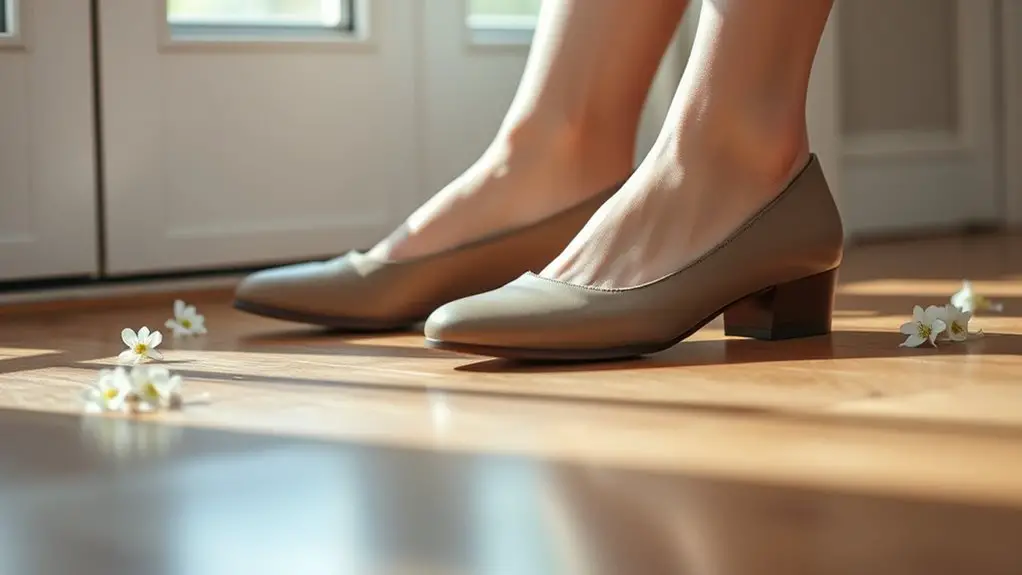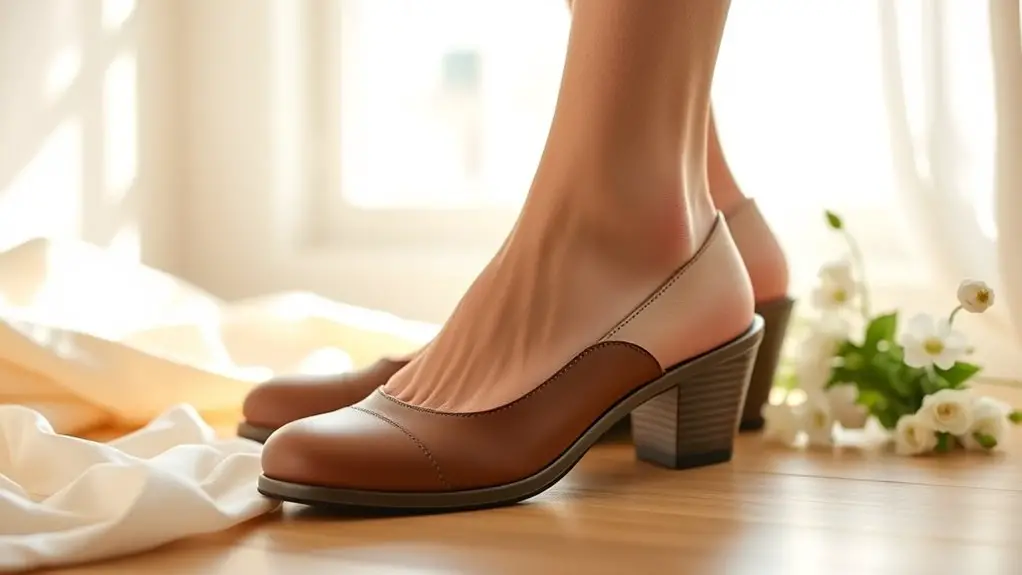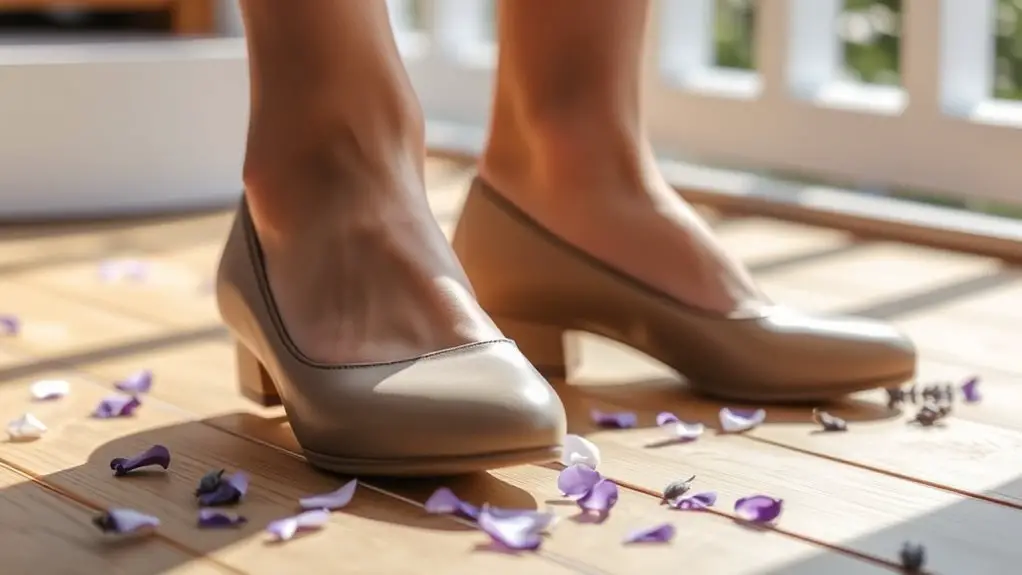The safest heel height for women over 50 is between one to two inches. This range promotes stability and reduces the risk of falls, vital as age can impact foot health. Lower heels enhance posture and provide added comfort, which is essential given potential issues like reduced fat padding and flattened arches. Choosing supportive footwear with these heel heights can make a significant difference. Keep exploring to uncover more tips for maintaining foot health and balance.
Understanding the Importance of Heel Height

Heel height plays an essential role in maintaining balance and stability, especially for women over 50. Understanding heel anatomy is important, as it directly influences foot biomechanics. The heel’s structure, including the calcaneus and surrounding ligaments, provides support and shock absorption. As you age, the soft tissues and muscles in your feet may weaken, making it imperative to choose appropriate heel heights.
Generally, a lower heel height is recommended to enhance stability and reduce the risk of falls. When you opt for heels above two inches, the risk of ankle instability increases, disrupting your foot biomechanics. Higher heels shift your body’s center of gravity, leading to an unnatural gait and potential discomfort. By selecting modest heel heights, you can promote better alignment and support, ultimately contributing to overall foot health. Prioritizing these factors will help you maintain mobility and confidence in your footwear choices.
The Impact of Age on Foot Health
As you age, various physiological changes can greatly affect foot health. Age-related changes such as decreased fat padding, loss of elasticity, and altered foot structure can lead to discomfort and instability. Your foot arches may flatten, resulting in overpronation, which can cause pain in the feet, knees, and hips. Additionally, joint stiffness and reduced circulation can make it harder for you to maintain balance, increasing the risk of falls.
You might also notice toenail growth slowing down or becoming thicker, leading to potential infections or discomfort. It is crucial to pay attention to these changes, as they can influence your choice of footwear. Proper support and cushioning become increasingly important to accommodate your evolving foot structure and maintain mobility. By understanding these age-related changes, you can take proactive steps to protect your foot health as you continue to enjoy an active lifestyle.
Recommended Heel Heights for Everyday Wear

When choosing heels for everyday wear, an ideal height is typically between one to two inches. This range balances comfort and stability while still allowing for a stylish appearance. It’s crucial to contemplate how comfort and style can coexist in your daily footwear choices.
Ideal Heel Height
Finding the right heel height is essential for women over 50, as it can considerably impact comfort and stability throughout daily activities. Ideally, a heel height between one to two inches is recommended for everyday wear. This range offers a balance between style and practicality, allowing you to stay fashionable without sacrificing support. When selecting heels, consider the materials; options like cushioned insoles and flexible heel materials can enhance comfort. While fashion trends may encourage higher heels, remember that your safety and well-being should take precedence. Opting for lower heels guarantees better posture and reduces the risk of falls, making it a wise choice for maintaining an active lifestyle. Prioritize your health while staying true to your personal style.
Comfort vs. Style
Many women over 50 face the challenge of balancing comfort and style in their footwear choices. While fashion trends often emphasize higher heels, it’s crucial to prioritize comfort, especially for daily wear. A heel height of 1 to 2 inches is typically recommended, as it provides a stylish look without compromising stability. When selecting shoes, consider the materials used; breathable fabrics and cushioned insoles can greatly enhance comfort. Look for styles that incorporate both modern aesthetics and supportive structures. By choosing wisely, you can enjoy fashionable footwear that meets your needs. Remember, your shoes should not only complement your outfit but also support your health and well-being as you navigate daily activities.
The Benefits of Low Heels
Low heels offer enhanced stability and support, making them a practical choice for women over 50. They markedly reduce the risk of injury while providing improved comfort and balance throughout daily activities. Choosing low heels can be a proactive step in maintaining both safety and well-being.
Enhanced Stability and Support
When it comes to footwear, choosing low heels can greatly enhance stability and support for women over 50. Low heels typically incorporate vital stability features, such as wider bases and improved traction, which help you maintain balance while walking. These shoes often use advanced support materials, like cushioned insoles and arch support, which can alleviate pressure on your feet, enhancing comfort during prolonged wear. Additionally, low heels reduce the strain on your joints, promoting better posture. By selecting shoes designed with these features, you can navigate various environments with confidence and ease. Prioritizing stability and support in your footwear choices is essential for maintaining mobility and overall well-being as you age.
Reduced Risk of Injury
Choosing low heels can considerably reduce your risk of injury, especially for women over 50. Adhering to heel height recommendations not only enhances your overall foot health but also plays an essential role in foot injury prevention. Low heels offer several key benefits:
- Improved stability: Lower heels provide a wider base, reducing the likelihood of falls.
- Reduced strain: Less pressure on the feet and lower back minimizes discomfort and potential injuries.
- Better posture: Low heels promote natural alignment, preventing musculoskeletal issues.
- Increased mobility: Easier to walk in, allowing for more active lifestyles.
- Enhanced circulation: Lower heels can improve blood flow, reducing swelling and discomfort.
Improved Comfort and Balance
Opting for low heels greatly enhances comfort and balance, which are vital for women over 50. Low heels provide better support for your foot arch, reducing strain on both the feet and lower back. This support helps maintain proper alignment, which is important for overall stability. Additionally, low heels promote ankle strength, allowing for improved mobility and reduced risk of falls. With a wider base, these shoes distribute weight more evenly, enhancing your overall posture. This not only alleviates discomfort but also encourages a more confident stride. By choosing low heels, you can enjoy the benefits of stylish footwear while prioritizing your comfort and safety, ultimately improving your quality of life as you age.
Choosing the Right Heel Height for Special Occasions
While selecting the right heel height for special occasions, it’s essential to contemplate both comfort and stability. You want to look stylish while feeling secure in your footwear. Here are some considerations to help you choose the best heel height:
- Occasion Type: Formal events may call for higher heels, while casual gatherings can accommodate lower ones.
- Duration: Consider how long you’ll be on your feet; shorter heels may be more appropriate for extended wear.
- Surface: Think about the terrain; uneven surfaces require lower heels for better balance.
- Personal Preference: Your comfort level with heel heights varies; choose what feels best for you.
- Foot Health: Take into account any existing foot conditions; prioritize comfort above all.
Footwear Features That Enhance Stability

When considering footwear for enhanced stability, several key features can greatly improve your safety and comfort. First, look for a shoe that supports your foot arch adequately. Proper arch support helps distribute weight evenly, reducing strain on your feet and lower limbs. This can considerably prevent discomfort during prolonged wear.
Next, focus on sole flexibility. A shoe with a flexible sole allows for natural foot movement, helping you maintain balance while walking. Rigid soles can impede your ability to adapt to uneven surfaces, increasing the risk of trips and falls.
Additionally, opt for a wider toe box. This feature provides extra room for your toes, enhancing comfort and stability. Finally, consider footwear with non-slip outsoles. They can offer better grip on various surfaces, further reducing the likelihood of slips. By prioritizing these features, you’ll enhance your overall stability while enjoying stylish options.
Alternatives to Heels for Stylish Options
If you’re looking for stylish alternatives to heels, there are several options that combine elegance with comfort. Choosing the right footwear can enhance your overall look while providing the support you need. Consider the following alternatives:
- Stylish flats: These come in various designs, from ballet to loafers, offering versatility for different occasions.
- Chic sneakers: Modern styles can elevate casual outfits, making them suitable for social events without sacrificing comfort.
- Ankle boots: They provide support and can be paired with skirts or trousers for a sophisticated appearance.
- Mules: Easy to slip on, mules add a fashionable touch without compromising stability.
- Wedge sandals: They offer height while distributing weight evenly, making them a comfortable alternative.
Exploring these options allows you to maintain your style and prioritize your foot health as you age. Choose wisely, and you can enjoy both comfort and elegance.
Tips for Maintaining Balance in Heels
To maintain balance while wearing heels, choosing supportive footwear is essential. Additionally, practicing proper heel walking techniques can greatly enhance your stability. Implementing these strategies will help you navigate in heels more safely and confidently.
Choose Supportive Footwear
Choosing supportive footwear is essential for maintaining balance in heels, especially as you age. Proper footwear not only enhances comfort but also reduces the risk of falls. Here are some options to evaluate:
- Supportive sandals with cushioned soles and arch support.
- Orthopedic sneakers that provide stability and shock absorption.
- Low-heeled options that distribute weight evenly.
- Shoes with a wider toe box to prevent pinching.
- Non-slip soles to improve traction on various surfaces.
Practice Heel Walking Techniques
Practicing proper heel walking techniques can greatly enhance your stability and confidence when wearing heels. Start by standing tall, distributing your weight evenly across both feet. As you begin heel walking, place the heel down first, followed by the toe. This technique practice minimizes strain on your ankles and enhances balance. Focus on taking smaller, deliberate steps to maintain control. Engage your core for added stability, and avoid looking down at your feet; keep your gaze forward. If you feel unsteady, practice walking on flat surfaces before moving to uneven terrain. Finally, consider using a wall or sturdy surface for support as you refine your technique. With consistent practice, you’ll find heel walking becomes more comfortable and secure.
Recognizing Signs of Foot Discomfort
Foot discomfort can manifest in various ways, and recognizing these signs early is essential for maintaining mobility and overall well-being. It’s important to pay attention to your feet, as ignoring discomfort can lead to more serious issues. Here are some common pain indicators you should watch for:
- Persistent foot fatigue after minimal activity
- Sharp or throbbing pain in any area of the foot
- Swelling or inflammation around the ankles or arches
- Numbness or tingling sensations while standing or walking
- Difficulty finding comfortable footwear
If you experience any of these symptoms, it’s important to assess your footwear choices and habits. Early detection of foot discomfort can prevent further complications and keep you active. Prioritizing foot health is essential, especially as you age, ensuring you can enjoy daily activities without pain or restriction. Stay attentive to your body’s signals for best foot care.
How to Transition to Safer Footwear Choices
Recognizing signs of foot discomfort is the first step in reassessing your footwear choices. Begin by examining your current shoes for inadequate arch support and unsuitable footwear materials. Shifting to safer options involves selecting shoes that prioritize comfort and stability. Look for footwear made from breathable materials that offer flexibility and durability.
Choose styles with a heel height of one inch or less to reduce strain on your feet. Opt for shoes with built-in arch support or consider using orthotic inserts to enhance comfort. When trying on new footwear, verify there’s enough room for your toes and that the shoes fit snugly without being tight.
Gradually introduce these safer footwear options into your daily routine to allow your feet to adjust. By making these informed shifts, you’ll enhance your foot health and overall well-being, guaranteeing you remain active and comfortable.
Frequently Asked Questions
What Are the Best Brands for Low-Heeled Shoes?
When considering low-heeled shoes, focus on brands like Clarks, Naturalizer, and Vionic. They offer comfortable styles with supportive features. These recommendations prioritize both comfort and style, ensuring you find the perfect fit for your needs.
How Do I Measure Heel Height Correctly?
To measure heel height accurately, place a ruler vertically against the heel’s back. Measure from the ground to the highest point of the heel for precise heel measurement, ensuring you achieve accurate sizing for your footwear choices.
Can Heel Height Affect Posture Over Time?
Studies show that 60% of women experience altered posture due to heel height. Over time, improper heel height disrupts posture alignment, leading to potential discomfort and long-term musculoskeletal issues if not addressed properly.
What Materials Provide the Best Support in Shoes?
When selecting shoes, look for materials that offer strong arch support and effective cushioning materials. These features help distribute weight evenly, reduce impact, and promote comfort, ultimately enhancing your overall foot health and stability.
Are There Exercises to Strengthen Feet for Wearing Heels?
Yes, incorporating foot strengthening and balance exercises into your routine can enhance stability when wearing heels. Try toe raises, calf stretches, and balance drills to improve strength and coordination, reducing the risk of injury.



